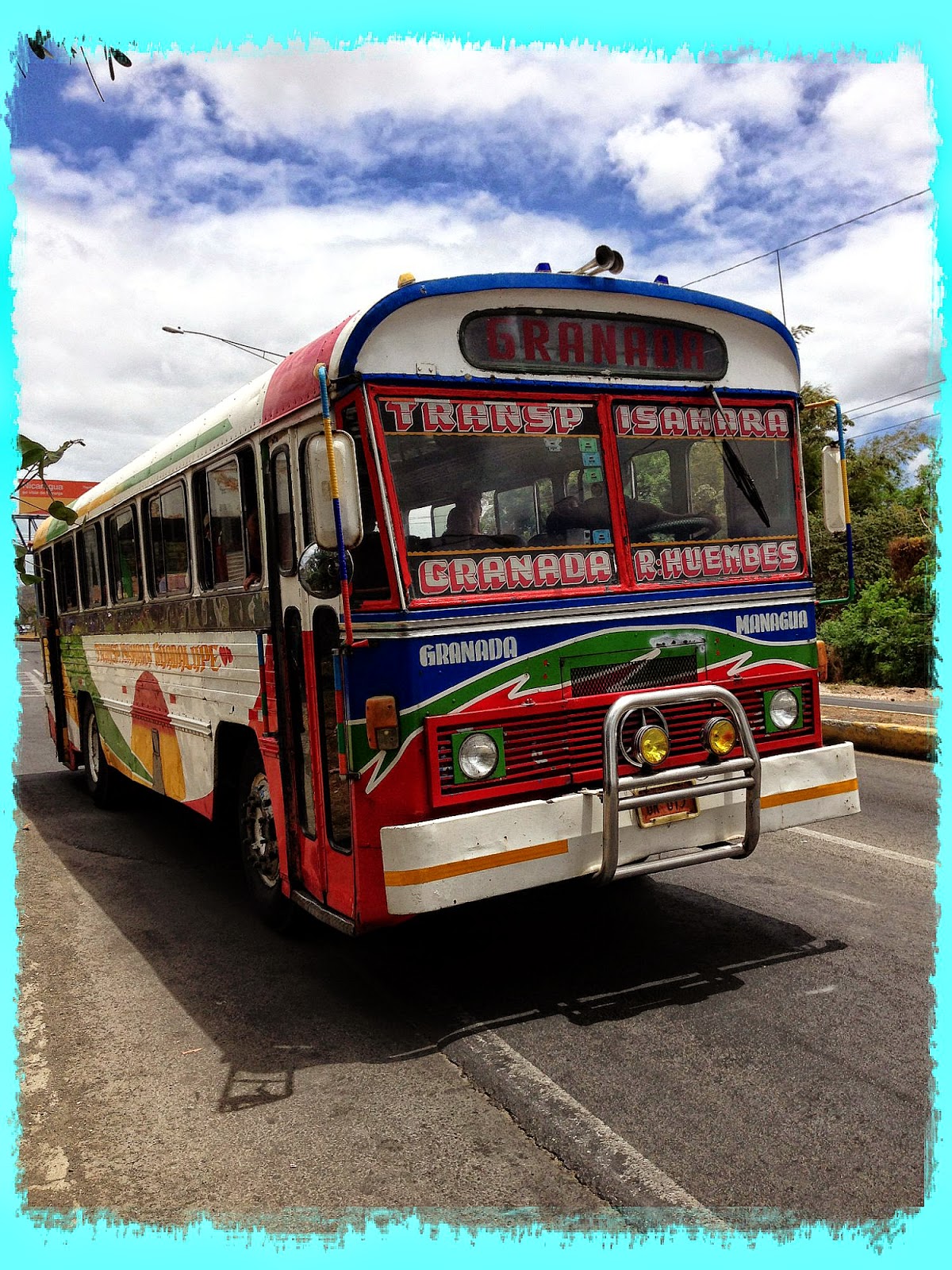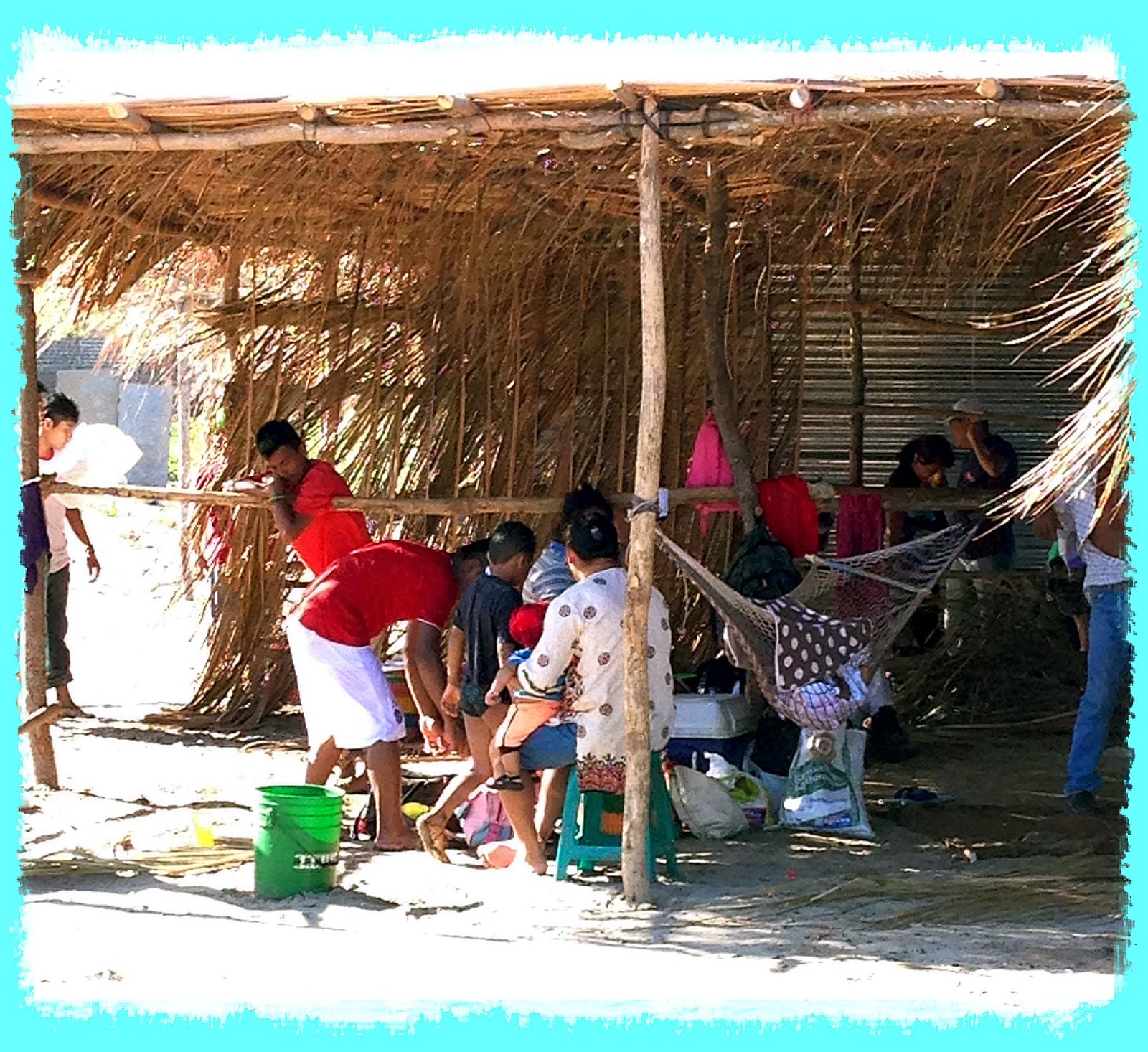
The ole' clocks were in their fifth of seven time zone changes we would experience on the trip. I just plain gave up trying to keep up and I quit updating my watch. Besides, Rick had a fancy, smancy wrist-doohickey that had GPS, world time, altitude, fax machine, printer, Dick Tracy walkie-talkie, etc., etc. (just kidding on the fax, printer and Dick Tracy) so I felt safe being lazy.
That day we had a long tour planned to visit Masaya Volcano National Park, see Lake Nicaragua, ride along the Pan-American Highway and experience Nicaraguan food.
But, before our day could begin, we needed to take a tender from the ship to shore. Our view as we motored towards land was of magnificent blue skies, sunshine and plenty of boats anchored in the port area on that gorgeous Sunday morning.


Once we stepped foot on land, we were greeted by dancers wearing traditional Trencilla costume. The men and women wore white outfits with colorful lines along the upper and lower portions. For further decoration, flowers and ribbons were added for color. The music was called Marimba consisting of percussion, guitar and what looks like a big xylophone. It was a festive and cheerful "hello".

Once everyone was on the tour bus, we began our adventure.

Like I have said before, it is a good travel habit to be educated about your host's "home" before you arrive. Being a traveler involves more than just "showing up". There are social etiquettes, dress codes, language basics, monetary changes, time changes, religious codes...all kinds of things, besides the history.
Knowing the history of Nicaragua is important because it reveals a deeper understanding and appreciation of its current state. Nicaragua has had a history of political and cultural upheavals. The name "Nicaragua" comes from the Nahuati-speaking tribe of Indians who originally inhabited the country. Their capital city was called "Nicarao". When the Spanish arrived in 1522, they combined the capital city name "Nicarao" with the Spanish word "agua", which means "water". Nicaragua struggled to become independent from Spain in 1821 but suffered through more political set backs and foreign rule for many years. Augusto Ce'sar-Sandino is Nicaragua's hero and martyr. He protested US military occupation in 1927 to 1933 and was assassinated when he tried to negotiate a cease-fire. He was 39 years old. Sandino remains to this day a symbol of resistance and national identity. For the next 43 years, Nicaragua rallied through a brutal dictatorship that started with the man who assassinated Sandino and seized power in a coup d'etat. Sandinista guerrillas, derived from the name Sandino, began a group of rebels, overthrew their ruler in 1979 and formed a new government. One of those Sandinistas was Daniel Ortega who would be known as a major figure for Nicaragua.
In the wake of the Contra War, which occurred in the 80's, the country was left uneducated, poor and with an almost 50% unemployment rate. From the 1980's through early 2000's, Nicaragua was in shambles. In more recent years, Daniel Ortega, who was re-elected, has attempted to bring Nicaragua back. Tourism has risen more than 70% in the last ten years.
I could see for myself the struggle with the old and the new. Transportation went from three wheeled bicycles and horse drawn carts to modern buses and cars.


Which leads me to a perfect segue. About 20 minutes into our tour, the air conditioning on our tour bus began to fail which subsequently led to a torn belt. This brought our bus to a halt and we were broken down on the roadside for just over an hour. While we waited for a replacement bus to arrive, Rick and I walked around and explored the immediate neighborhood. A man on a three wheeled bike stopped, smiled and let us sit in the seat up front for a photo moment.


The local Lions Club celebrated their 60th anniversary last year. Cheers.

This home had chickens and pretty blooming flowers outside. We were told by our guide that homes were made of materials from brick and mortar to pieces of aluminum and plywood.

Replacement arrived! Just in time since we were all feeling "well done" from the searing heat. By then it was 33C (91.4F) and climbing. Being closer to the equator made a big difference in the heat factor, making the sun more intense.

Up and running, we stopped for a breathtaking opportunity to see the gorgeous, bright blue Apoyo Crater Lagoon. The name "Apoyo" came from the Nahuati language "Ati-poyec" which means "brackish water". "Brackish" refers to the minerals still found in the lake. Traditional Nahuati is an Aztecan language originally communicated in pictographs (pictures). The Spaniards brought Latin to Nicaragua and used this to translate Nahuati into alphabet form. The last eruption occurred some 21,000 years ago and left a massive indentation in the earth, some 200 meters (656 feet) deep. The water remains an average 80F (27C) all year long and offers great swimming, hiking and walking opportunities. Or, maybe just a picnic by the picturesque lake.


Naturally, in the land of volcanoes, a must see would be the Masaya Volcano National Park which boasts two volcanoes and five craters. Halfway up the steep incline to Masaya Volcano was a tourist/information center where we stopped for a short while. If you were searching for further knowledge on the flora and fauna of the area, this center would provide it. We then continued our drive up to the top of the crater. There we had the opportunity to stare down into an active volcano, which last erupted in 2003. It continually emits smoke and sulphur gas, so there was a restriction on the amount of time you could stand near the edge and breathe in the sulphur. There were trails that led to various great views, other craters or the Tzinaconostoc Cave, home to hundreds of bats. The trails required guides and were extra in cost, time and physical exertion. The landscape looked barren and craggy, like a rocky desert, with wisps of grass. All were once immersed in lava flow.









That day I was not feeling well and the heat was getting to me. Twice I had to stay on the bus while Rick got off and took the photos and experienced the "moment". Lunch that day was in an open air steak restaurant called "El Filete Steakhouse". So a meal outdoors was not my first choice because it was so warm, but fans were blowing, it was shady and I needed to acclimate. The establishment was beautiful, colorful and the service courteous and generous. Cuisine was very good and featured local items such as tortillas, rice, red beans, plantains, fish, beef and chicken. There was a opportunity to try "Pinolillo" (or Pinol) which was a cornmeal and cacao based drink you can drink sweetened or unsweetened and was a strong tradition in Nicaragua. The drink was so widespread and popular that Nicaraguans referred to themselves as "Pinoleros", either jokingly or with pride. Since I was not feeling my usual self, I did not try it. Oh, and while we ate, we were serenaded by a Mariachi band.






The colors were fabulous and I loved how the people of Nicaragua boasted such vibrant and cheerful hues. And, I spotted another Tuk Tuk...fun, fun, fun.



It was time we headed back to the port area. So our drive "home" would be along the Pan American Highway, the longest series of motor driven routes in the world (requires a ferry be taken between Panama and Colombia to bypass the Darien Gap). How long, you were asking? Approximately 30,000 miles long (48,000 kilometers).
 (map courtesy of internet)
(map courtesy of internet)
Along our way, we stopped at the famous Lake Nicaragua. The Pan American Highway getting there was very windy so windmills were used to harness this. Approximately 25% of the energy used in Nicaragua was clean energy. They also produced ethanol from sugar cane and exported that. There was also a hydroelectric power plant we did not see that was another source of smart energy.


Again, it was a Sunday so we witnessed families relaxing by the lake in large groups. Makeshift lean-tos on the sand were easy, breezy equivalents to what we called cabanas in the States. Some interesting facts about the lake: it was freshwater, relatively shallow and was the home to plenty of bull sharks, a more aggressive and unpredictable species. We saw people just wading far out into the lake and it was only knee deep, similar to a large sandbar. I was born and raised in Florida (and I saw the movie "Jaws") so the mention of sharks always gets my full and immediate attention. However, none of the bathers seemed concerned that day.




Back at the ship once more, we enjoyed how the sun set on the cliffs before us and created a reddish gold hue. Lovely!

Nicaragua was really lovely in a pure, simple way. I personally felt that when a country celebrated everyday existence in the colors I saw that day, it sent a message that they had energy, passion, pride and hope. You have to immensely respect any people that had endured so much in the past and did not give up on the future. Thank you Nicaragua for a great day.
On to our last port of call, Puerto Vallarta, Mexico: South American Cruise 2014

No comments:
Post a Comment